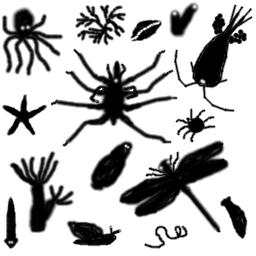Center for Invertebrate Biology

This site is dedicated to providing information about the biology of invertebrates, the other 99% of animals.
An invertebrate is any animal that lacks a backbone. Most animals are invertebrates, with the largest animal group being the Arthropoda (Chelicerata, Crustacea and Insects). Insects are the largest of the invertebrate groups and beetles the largest insect group.
Historically, animals have been split into two groups: those with a backbone (vertebrates) and those without a backbone (invertebrates). Vertebrates are all descended from a common ancestor which had evolved a backbone and hence represent a ‘monophyletic’ group. Invertebrates are a ‘polyphyletic’ group composed of many different groups that are very distantly related to one another. In fact vertebrates evolved from an invertebrate ancestor.
The first animals were invertebrates and appear in the fossil record during the last period of the Precambrian, the Vendian period. The unique fossils from this period are termed the Ediacaran fauna and range in age from ca. 560-580 mya. Animal fossils from the Ediacaran fauna were mostly softbodied and include sponges, cnidarians (jellyfish), worm tracks, and many frond-like animals. The animal diversity that we see today began during the Cambrian period (ca. 490-542 mya) when animals became much more complex and a large number of body forms evolved. This is often referred to as the “Cambrian explosion” and is best represented by the fossils found in the Burgess Shale near Field, British Columbia, Canada.